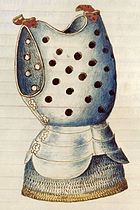- Nasal helmet
-
 Image of Harold Godwinson from the Bayeux Tapestry. Harold and his huscarls are depicted in nasal helms.
Image of Harold Godwinson from the Bayeux Tapestry. Harold and his huscarls are depicted in nasal helms.
The nasal helmet is a type of combat helmet used from the Early Middle Ages until the High Middle Ages.
The nasal helmet was a form of helmet with a domed or raised center, usually formed around a basic skull-cap design, with a single protruding strip that extended down over the nose to provide additional facial protection. The helmet appeared throughout Europe late in the 9th century, and became the predominant form of head protection, replacing the previous pudding-bowl design, and the Vendel-style spectical helm. One of the earliest versions of the nasal helm is the Vasgaard Helmet. The Bayeux Tapestry features many such helmets, it being the most popular form of protection at the time. The helmet began to lose popularity at the end of the 12th century to helmets that provided more facial protection, and although the nasal helm lost popularity amongst the higher classes of knights and men-at-arms, they were still seen amongst archers to whom a wide field of vision was crucial. The helmet can also be viewed throughout the Maciejowski Bible as a minority item for cavalrymen, giving the impression that it had become uncommon (though not unknown) by the mid-thirteenth century.
Nasal helmets have been found of both one-piece and Spangenhelm construction, with the later period helmets being made of a single, smooth raised dome to allow weapons to glance off with ease.
Head Armet · Barbute · Bascinet · Burgonet · Cervelliere · Close helm · Close helmet · Great helm · Frog mouth(helm) · Hounskull · Lobster tail pot · Mail coif · Morion · Nasal helmet · Sallet · Spangenhelm · Kettle hat
Visor · Falling buffe · Nossel
Neck Torso Brigandine · Cuirass · Culet · Plackart · Fauld · Hauberk · Codpiece · Lance rest · Loin-guard · Jack of plateArms Legs Component pieces 
This medieval armour-related article is a stub. You can help Wikipedia by expanding it.

